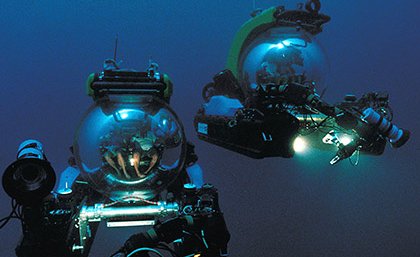
University of Queensland marine neuroscientists are plunging to new depths in submersibles on the Great Barrier Reef and in the Coral Sea.
Using the state-of-the-art Dalio Foundation exploration vessel MV Alucia as their base, UQ researchers will spend three weeks’ investigating the waters in and around Queensland’s reef systems.
Professor Justin Marshall of UQ’s Queensland Brain Institute said the MV Alucia’s manned submersibles would enable researchers to explore the reef in exciting new ways, diving to “previously impossible” depths of 300 m.
“We want to explore the Great Barrier Reef and Coral Sea in ways not possible before, and share the experience with the world,” Professor Marshall said.
“By using manned submersibles here for the first time, and with the incredible technology the MV Alucia provides, we hope to contribute new data to baseline descriptions of ecosystems and events in what is effectively our own back yard,” he said.
“This comes at a tremendously important time for Australia’s reefs. Any new information we can glean to demonstrate how important it is to preserve these unique habitats for future generations is invaluable.”
The MV Alucia was co-designed as a research platform by Professor Marshall, as part of an Australian Research Council Linkage Project.
He said this was the first time it had operated in Australian waters, undertaking the work it was originally designed to for.
“The vessel was designed to be able to launch submersibles and observe life beyond the depths divers can reach as well as examine specimens aboard the ship while we’re out in the field,” Professor Marshall said.
Expedition coordinator Dr Adrian Flynn was a UQ PhD student when he became one of the first people to describe the annual deep-sea lanternfish spawning in the Coral Sea.
He is now director of consulting firm Fathom Pacific Pty Ltd, and hopes to investigate lanternfish spawning using new technologies.
“What we are examining is the largest daily migration of animals on the planet. Dr Flynn said.
“In November every year these fish aggregate to spawn in extraordinary numbers, attracting spectacular feeding and spawning aggregations in a range of predatory species from sharks to tuna and seabirds.
“We will be using remotely operated vehicles, state-of-the-art video systems, nets and other techniques to study the biology of the lanternfish aggregation and its significance in the oceanic ecosystem.”
Professor Marshall said a Triton Submersible operating from the MV Alucia would take three crew members – a pilot and two observers – to depths of 300 m.
He said the generosity of the Dalio Foundation was providing an invaluable opportunity to explore the Great Barrier Reef and Coral Sea at previously impossible depths.
The vessel will be in Australian waters for three weeks in October and November.
Media: Darius Koreis, +61 7 3346 6353, d.koreis@uq.edu.au; Professor Justin Marshall, +61 7 3365 1397, +61 423 024 162, justin.marshall@uq.edu.au
.jpg)










